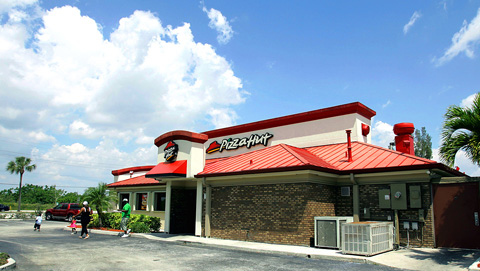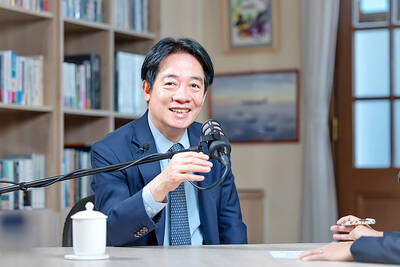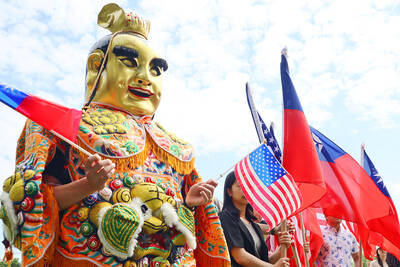Dan and Frank Carney borrowed US$600 from their mother 50 years ago and opened a small pizzeria in Kansas using secondhand equipment in what was once a bar.
The dream was to make enough pizzas to pay for college and earn a little money on the side for the family.
That humble enterprise with a humble name — Pizza Hut — is now the world’s largest pizza chain with US$10 billion in annual sales and more than 11,000 stores worldwide.

PHOTO: AP
“We were able to build something from nothing,” Dan Carney said, recalling the hardscrabble early days and that first pizzeria in Wichita, Kansas, which opened 50 years ago yesterday.
The chain known for its red-roofed restaurants is now updating its look, with plasma TVs, sports bars and local sports memorabilia.
It’s also rolling out tubs of baked pasta and piles of fried chicken wings to go with its famous pizzas.
It is a tough time for pizza makers, who are strapped by rising cheese and flour costs and consumers who have been pinched by a sluggish economy.
Last year, Pizza Hut Inc closed more US restaurants than it opened, which it attributes to such factors as leases ending and restaurants being sold.
Analysts say Pizza Hut was due for an overhaul, and the new menu may help it through a rough time for the industry.
Restaurant analyst Larry Miller with RBC Capital Markets said “the iconic red roof store is dated.”
“From a bigger picture, longer-term view, this is a brand that’s starting to differentiate itself from the competition in some really unique ways,” he said.
Pizza Hut went public in 1970 and was then acquired by PepsiCo Inc in 1977. Frank Carney left the company three years later in a clash with the new owners.
Pizza Hut’s corporate parent changed again in 1997 when PepsiCo spun off what is now Yum Brands Inc, a Louisville-based company that also owns Taco Bell, KFC, Long John Silver’s and A&W All-American Food Restaurants.
“I’m proud every time I see Pizza Hut doing well because that’s part of me,” Frank Carney said.
Now 70, he is a competitor with a stake in 73 Papa John’s pizza stores in Wichita, Hawaii and Houston, Texas.
“Good competition keeps everybody on their toes, them and us,” Carney said.
Pizza Hut began an aggressive advertising campaign this spring to publicize the new menu. It says the effort paid off in the first month, when it sold 2 million pans of pasta, doubling its expectations, Pizza Hut president Scott Bergren said.
The company sells chicken wings in an agreement with WingStreet.
“We have changed our sales mix substantially,” Bergren said.
Bergren declined to say what kind of profit margins the company was seeing for pasta and chicken wings compared with pizza, saying, “these are all profitable products.”
Ingredient costs like wheat, cheese and chicken have soared in the past year.
Bill Walsh, a Pizza Hut franchisee with a stake in 93 stores in a dozen states, said the menu has bolstered sales at his restaurants.
While restaurants have incurred higher costs and extra equipment expenses, “by the time you get those additional sales, we’re happy to accept that higher food cost.”
Pizza Hut is quick to emphasize that it will stay true to its name.
“Our core, and Lord knows we sell more of it than anybody in the United States, it’s always going to be pizza,” Bergren said.
While the chain’s most heated growth is now overseas, Bergen said there is room to expand at home.
“We think there are another 1,000 towns in the United States where we can actually build a Pizza Hut,” he said. “So we’re not done growing in the United States at all.”
Dan Carney, 76, has left the pizza business, but still keeps an eye on the company he founded 50 years ago in a rented bar with his brother.
“I’d love to see it go another 50 years,” Carney said. “As long as they stay dynamic with new ideas flowing in and out, they have a great chance to do that.”

Nvidia Corp yesterday unveiled its new high-speed interconnect technology, NVLink Fusion, with Taiwanese application-specific IC (ASIC) designers Alchip Technologies Ltd (世芯) and MediaTek Inc (聯發科) among the first to adopt the technology to help build semi-custom artificial intelligence (AI) infrastructure for hyperscalers. Nvidia has opened its technology to outside users, as hyperscalers and cloud service providers are building their own cost-effective AI chips, or accelerators, used in AI servers by leveraging ASIC firms’ designing capabilities to reduce their dependence on Nvidia. Previously, NVLink technology was only available for Nvidia’s own AI platform. “NVLink Fusion opens Nvidia’s AI platform and rich ecosystem for

‘WORLD’S LOSS’: Taiwan’s exclusion robs the world of the benefits it could get from one of the foremost practitioners of disease prevention and public health, Minister Chiu said Taiwan should be allowed to join the World Health Assembly (WHA) as an irreplaceable contributor to global health and disease prevention efforts, Minister of Foreign Affairs Lin Chia-lung (林佳龍) said yesterday. He made the comment at a news conference in Taipei, hours before a Taiwanese delegation was to depart for Geneva, Switzerland, seeking to meet with foreign representatives for a bilateral meeting on the sidelines of the WHA, the WHO’s annual decisionmaking meeting, which would be held from Monday next week to May 27. As of yesterday, Taiwan had yet to receive an invitation. Taiwan has much to offer to the international community’s

CAUSE AND EFFECT: China’s policies prompted the US to increase its presence in the Indo-Pacific, and Beijing should consider if this outcome is in its best interests, Lai said China has been escalating its military and political pressure on Taiwan for many years, but should reflect on this strategy and think about what is really in its best interest, President William Lai (賴清德) said. Lai made the remark in a YouTube interview with Mindi World News that was broadcast on Saturday, ahead of the first anniversary of his presidential inauguration tomorrow. The US has clearly stated that China is its biggest challenge and threat, with US President Donald Trump and US Secretary of Defense Pete Hegseth repeatedly saying that the US should increase its forces in the Indo-Pacific region

ALL TOGETHER: Only by including Taiwan can the WHA fully exemplify its commitment to ‘One World for Health,’ the representative offices of eight nations in Taiwan said The representative offices in Taiwan of eight nations yesterday issued a joint statement reiterating their support for Taiwan’s meaningful engagement with the WHO and for Taipei’s participation as an observer at the World Health Assembly (WHA). The joint statement came as Taiwan has not received an invitation to this year’s WHA, which started yesterday and runs until Tuesday next week. This year’s meeting of the decisionmaking body of the WHO in Geneva, Switzerland, would be the ninth consecutive year Taiwan has been excluded. The eight offices, which reaffirmed their support for Taiwan, are the British Office Taipei, the Australian Office Taipei, the